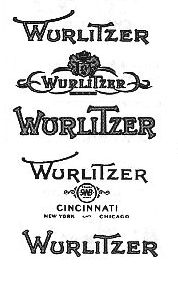Manufacturers Index
A B C D E F G H I J K L M N O P Q R S T U V W X Y Z
| Featured Pianos | Piano Company Profiles |
| Pianos We've Restored |
 WE ARE GRATEFUL TO CELEBRATE BEING IN BUSINESS DOING WHAT WE LOVE FOR 50 YEARS
WE ARE GRATEFUL TO CELEBRATE BEING IN BUSINESS DOING WHAT WE LOVE FOR 50 YEARS
— SINCE 1974 —
REGISTERED PIANO TECHNICIAN
— SINCE 1982 —
A B C D E F G H I J K L M N O P Q R S T U V W X Y Z
| Featured Pianos | Piano Company Profiles |
| Pianos We've Restored |
 Perhaps there's something magical about the sound of the name itself, but Wurlitzer is a name that has truly branded itself into the American imagination, and even the American dialect. Not just with consumers, but also with authors and historians, the name, Wurlitzer, is usually mentioned in the historical accounts of American piano manufacturing, but even more, the name has come to mean a whole historical atmosphere. In other words, if not magical, Wurlitzer is certainly somewhat mythical. The name conjures memories and day dreams about the big American city, its society life and the intense and masterful productions surrounding the spectacular pipe organs in the upscale theaters of city centers all across the United States. Of course, not each and every one of the popular, attention stealing instruments was manufactured by Wurlitzer & Company. Nevertheless Wurlitzer & Company became such a magical name that now, in movies, in conversation, between actors and musicians, Wurlitzer is still easily associated with the great halls and spectacular musical events of a rapidly growing, prideful country. It would be the name that would conjure in our hearts and minds, the live stage and the exciting new technologies emerging in a hopeful new century, including silent film and the recording industry. Indeed, especially for the Boomer age, in soda shops and famica tabled cafes all across America, the Wurlitzer Jukebox, looking more organic and alive than machine like, would collect our dimes and quarters for decades to come.*
Perhaps there's something magical about the sound of the name itself, but Wurlitzer is a name that has truly branded itself into the American imagination, and even the American dialect. Not just with consumers, but also with authors and historians, the name, Wurlitzer, is usually mentioned in the historical accounts of American piano manufacturing, but even more, the name has come to mean a whole historical atmosphere. In other words, if not magical, Wurlitzer is certainly somewhat mythical. The name conjures memories and day dreams about the big American city, its society life and the intense and masterful productions surrounding the spectacular pipe organs in the upscale theaters of city centers all across the United States. Of course, not each and every one of the popular, attention stealing instruments was manufactured by Wurlitzer & Company. Nevertheless Wurlitzer & Company became such a magical name that now, in movies, in conversation, between actors and musicians, Wurlitzer is still easily associated with the great halls and spectacular musical events of a rapidly growing, prideful country. It would be the name that would conjure in our hearts and minds, the live stage and the exciting new technologies emerging in a hopeful new century, including silent film and the recording industry. Indeed, especially for the Boomer age, in soda shops and famica tabled cafes all across America, the Wurlitzer Jukebox, looking more organic and alive than machine like, would collect our dimes and quarters for decades to come.*
Besides the grand connotations associated with the Wurlitzer name, it just might be an altogether different reason why the Wurlitzer name is so thoroughly branded into our collective brain: Wurlitzer is the first American piano company to open the general, middle class, increasingly urban American public to the prospect of a well made, good sounding, sturdy, but small -- even portable -- piano that can fit in a smaller space, like a mid-town city apartment. And thus, in the mid 1930s, Wurlitzer hit the American piano market by storm with the spinet, a piano with a full-sized keyboard and a full set of strings, and yet, standing a mere 36 inches high.
The grand pianos made by Wurlitzer during the 20th century were considered to be "work horse" type pianos, so called "commercial" pianos along the lines of a Kimball Company piano or a Cable Company piano. These pianos were not in league, nor did they intend to be in league with the Steinways, the Mason & Hamlins, or perhaps even the Chickerings. The idea was to have a Wurlitzer grand piano, baby grand piano, upright, studio or spinet in every living room of every old and new home in the United States. The professional musicians and students would be using other, better built pianos to perform on, but most likely they would find their hands playing a Wurlitzer in a practice room or at a cocktail party from time to time. In this way, Wurlitzer pianos were good enough, made with wood and steel from the U.S. and built here, too.
The pianos made by Wurlitzer & Company have stood their ground over the years, and even though the Baldwin Piano Company now owns the Wurlitzer name, it is still respected enough for Baldwin to use the Wurlitzer name on certain lines. If you have a piano with the Wurlitzer name and would like to discuss the prospects of restoration, refinishing, refurbishing or repair, please contact Michael Sweeney directly. Michael will be glad to help you assess the prospects of repair and/or complete restoration of your Wurlitzer piano.
*At least in name, the Wurlitzer Jukebox enjoyed an almost ubiquitous presence in the 1950s and 1960s. They quickly became a mandatory fixture in every kind of public social scene, save libraries and churches. Especially significant in small towns where very little live, musical public social entertainment could be found, the Jukebox brought professionally recorded music into the lives of an entire post war generation. Here, too, the Wurlitzer name became branded in our minds as the word synonymous with the Jukebox. As Joni Mitchell writes in her the lyrics to an old song looking back:
He put a quarter in the Wurlitzer
and he pushed three buttons
and the thing began to whirr..."
-- Joni Mitchell, "The Last Night I Saw Richard"
In 2002, commending the piano's 300th birthday, author and historian, James Parakilas, wrote a storybook-like tale of the piano's interesting history, a tome that treats the piano almost like a person, but even more as the truly magical object that brought people together in so many different fields of interest. The piano was truly, Parakilas believes, this thing with a magnetic power to hold the social world together in a single room, across towns and nations, the power to "socialize" a crowd of strangers.
The piano has always been an exciting crowd gatherer and crowd pleaser, and this is true for a good two thirds of the 19th century, but true, as well, through the 20th century and even into the 21st. Parakilas himself gives us a rich, romantically tinged account of the piano in both its grand and upright postures. He also says of the piano that it's "clearly an instrument for the expression of a romantic personality...", saying beautifully, too, that pianos are worth loving.*
Social histories of the piano often highlight how the piano is much more than a mere machine or instrument. It is one of the great results of human imagination and human production. And because it is a musical instrument, a history of the piano will ultimately be a cultural history infused with aesthetic meaning. And as a cultural history, it is interesting to follow the line of production, to see first hand how the natural materials from which pianos are made do in fact take on cultural significance. As pianos interact with its composers, its players and its audience, it becomes humanized, sometimes even to the point of intense controversy.
Parakilas investigates this cultural history with a certain intention. He wants to highlight ways in which the piano acts as a type of mediator.
...the piano has always exhibited a unique power to act as a cultural go-between, as a medium through which social spheres that stood in opposition to each other could nonetheless nourish each other.
*If Parakilas implies that the piano deserves our love and respect because they have been like hosts to our social gatherings and mediators and even menders of our cultural tensions and frustrations, especially when love implicates us in a call to protect that which we love, from that should we not gather, too, that if good pianos are worth loving, they are worth repairing and restoring?
Also: Those humans fortunate enough to know a piano, and more to have fallen in love with a piano, will understand exactly what it means when it comes to experiencing the piano's mysterious hold over the human heart.
Sources for this information include Michael Sweeney's 30+ years experience in the piano restoration business as well as the following texts: Piano Roles: A New History of the Piano by James Parakilas;Giraffes, Black Dragons, and Other Pianos: A Technological History from Cristofori to the Modern Concert Grand, Second Edition by Edwin M. Good; Men Women and Pianos, A Social History by Arthur Loesser, and Pierce Piano Atlas by Bob Pierce.
A B C D E F G H I J K L M N O P Q R S T U V W X Y Z
| Featured Pianos | Piano Company Profiles |
| Pianos We've Restored |